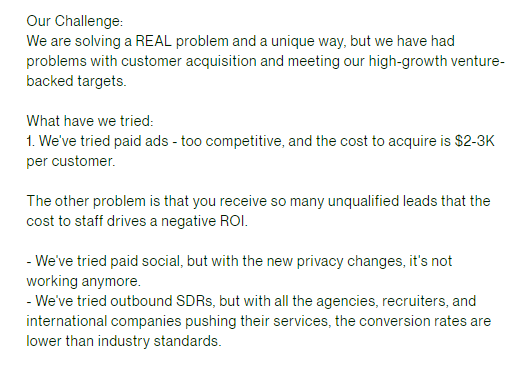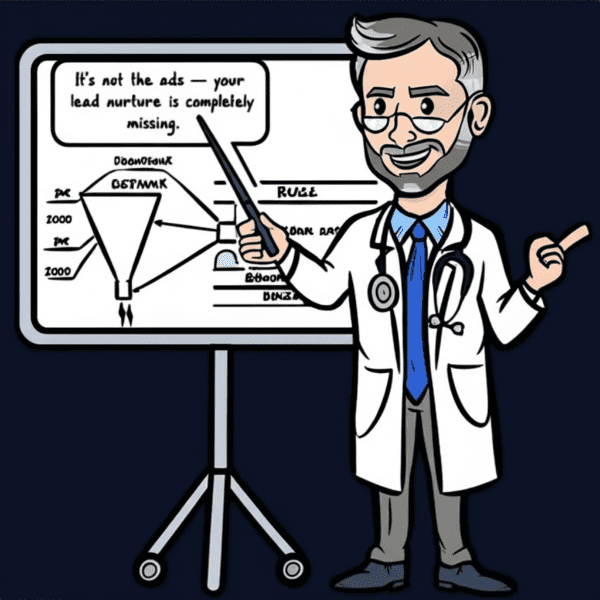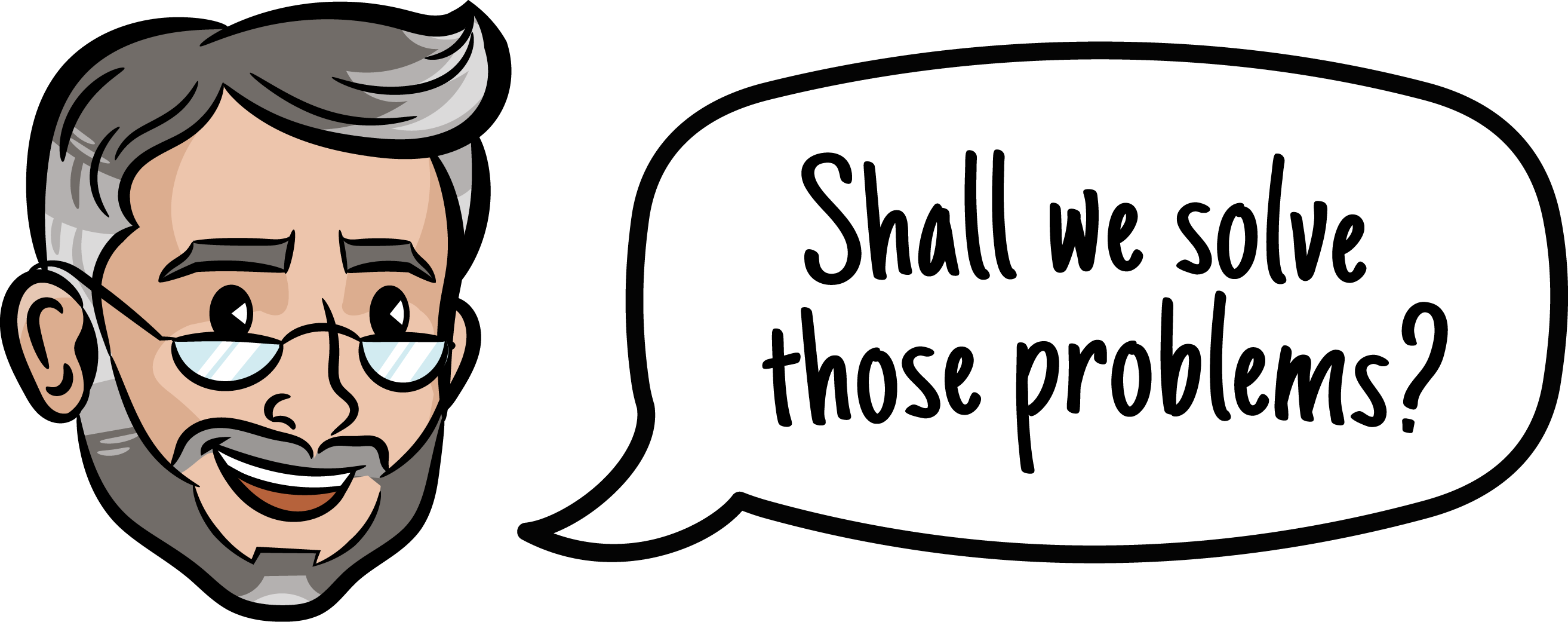A classic challenge for many firms is understanding what’s wrong within a broken sales funnel and in their go-to-market strategy overall (to the extent that they have one).
CFO: “We’ve spent $500k on this f@$#ing initiative and have nothing to show for it!”
CEO: “Google ads are terrible. We’re never doing that again!”
Have you ever heard statements similar to these? They’re not uncommon, especially in firms that don’t understand digital go-to-market strategies.
In this article, we’ll examine the common phenomena where companies that don’t really understand best practices at each step in their funnels end up drawing incorrect conclusions and then setting money on fire trying new things in the wrong part of the funnel.

Here’s a Real Call for Help from a Company Trying to Understand Why Its Sales Funnels Aren’t Scalable

Some Context on This Firm with a Broken Funnel
- The request for help is from a real company with a real problem. They are struggling to accelerate their sales.
- Their point of differentiation is they sell a premium or “white glove” version of an existing service and compete with a number of publicly-traded companies in the broader market for their services.
- They have taken outside investment (venture capital) and have the added pressure of meeting or exceeding those investors’ expectations.
- They’ve tried a number of top-of-funnel approaches:
- “Paid Ads” in this case means Google PPC or “Search” ads.
- “Paid Social” likely means Facebook or LinkedIn (given they are B2B).
- “SDRs” means “Sales Development Reps,” which means they tried outbound calling or an “Inside Sales” approach.
- They think their problem is within their top-of-funnel and a new top-of-funnel approach or fix to an existing one might be their solution.
- They are sophisticated enough to be calculating their cost of acquisition (CAC).
If you need help explaining broken funnels to your staff or students try using our free sales funnel illustrations.
What Could We Quickly Spot?
Without auditing their sales funnel, we quickly began to see some familiar patterns that led us to believe this company’s sales funnel problems were more closely correlated with middle-of-funnel issues than top of funnel.
Websites are easy to audit because they’re public, and we see tons of easily correctable errors all the time, even within the websites of publicly-traded companies and those with branded venture capital investors.
Issue 1: This company’s reason for existence is to be the “white glove” option within its space. Its hero section describes the space, not the differentiation. The “Hero” section or Section 1 of a website that is visible when you open the website’s job is very simple: Convince the reader to keep reading.
Since this company is an unknown brand and restating the entire space, it comes across as a clone.
“Sure, I’d love to switch tools to the company I’ve never heard of that does exactly the same thing,” said no one, ever.
Issue 2: In the same direction as the hero, the home page is almost entirely a restatement of what the space is. We call this kitchen-sinking. Throw a ton of features at visitors and pray they buy because “there’s a lot of stuff here!” This is also known as spray and pray.
This company finally gets to its point of differentiation in its 4th section from the top.

Issue 3: If you’re positioning as the white glove version, you need that level of polish everywhere. If you want to position yourself as the Ritz-Carlton to the incumbent’s Best Western, your marketing, sales, and product teams need to uphold that standard of care and attention to detail everywhere.
How Should a “White Glove” Option in a Crowded Field Appear?
Here are some examples of polishing errors that we catch in our funnel audits and 3D Proofreading work. No company can maintain a 100% spotless digital surface.
Since this company chooses to position itself as “like brand x but the white glove experience,” the standards are higher. People will infer that the quality of the underlying service is the same as the presentation layer: the website, in this case.


Our 3D proofreading service catches these types of issues.


So this company needs to go through all of their client-facing material and polish it. Word choice, spelling, noun-verb agreement, image selection, etc. need to sell the fact that “this is the top-quality version in the space, and we are entitled to charge what we do because of the quality.”
What Are the Consequences of Not Finding the Correct Diagnosis?
If you read the request for help again, you can tell the author believes the problem lies at the top of the funnel:
Google ads aren’t working.
Algorithm changes in social media killed that channel.
SDRs couldn’t catch up to industry standards.
Guess what: the cost of acquiring clients is calculated on what comes out of the small end of the funnel. This company has a severely pinched middle-of-funnel, so of course, much less makes its way through to the closer team at the small end of the funnel.
In statistics, we have what’s called a confound.
The author thinks the independent variable (the top-of-funnel approach) is tightly correlated to the bottom-of-funnel dependent variable (closed business). In this case, the reality is there is another, hidden variable (middle-of-funnel quality) that is dragging the conversion rate down.
Consequence 1: Google and the Social Networks May Become More Expensive
Google, Facebook, LinkedIn, and others are auction-based tools. If your ad showed, somebody else’s ad did not.
If you had the campaigns set to maximize conversions (and the website converts poorly due to poor positioning and lack of proofreading), your ads may get shown less because the algorithm can’t find enough people who will convert under your price ceiling.
With the right PPC intelligence in place, this company/team should have been able to discern what actual phrases were being bid on within Google Ads. If the phrases made sense for their target audience while in their buying cycle and the ad copy was solid, a middle of funnel problem was more likely the culprit.
Consequence 2: Good SDRs Get Mad & Quit
Your sales team is hyper-aware of client perceptions. They want everything your potential clients can see and touch to reinforce what they are saying.
If your sales rep is saying we are the best in the business and your potential client sees errors everywhere in the marketing, or even worse, within the platform, they’re going to have a hard time convincing clients to move forward. They may get a lot of “soft blow-offs” such as the dreaded “call back in 6 months” response.
Great sales reps are ultimately motivated by variable compensation. If they become aware of these types of problems and don’t see management taking corrective action, they’ll simply assume their OTE quote was a joke leave and sell a higher-quality product that makes them more commission.
Consequence 3: The Company Starts Investing in More Top-of-Funnel or Features That Won’t Accelerate Sales Because the Middle of the Funnel Is Still Pinched
This is probably the worst of all the consequences. Startups can disappear when a confused management team uses investor funds to pursue ever more obscure approaches to acquiring clients without solving their fundamental messaging and positioning problems.
So What Should This Company Do to Fix Its Sales Funnel?
The immediate goal for this company is to do whatever it can to clean up its website and get more throughput in the middle of its funnel:
- Clean up all the copy. Use a fine-toothed comb to remove as many errors as possible. The original writer of these pages should not be tasked to do this.
- Lead with the value proposition. Explain how their approach is fundamentally different and makes life better for their audience and then cover the features to let people know they still do all the table stakes items.
- Apply the same thinking to the Google Ads, Facebook Ads, the collateral used by the SDRs, and the app itself. When clients see low quality on the first impression, they’re usually correct that the entire offering is low quality. This company might get significantly better click-through rates on their ads if they’re currently showing ads with spelling errors, unclear value prop, etc.
Many companies in this situation see rapid improvement when a fractional Head of Growth steps in to realign the funnel, tighten messaging, and remove the middle-of-funnel bottlenecks holding revenue back.
Do You Need Help Fixing Your Sales Funnel?
Reach out to Sales Funnel Professor. Our audits were designed to get all of these blockers out of the way so that your funnel and revenue significantly expand. We provide 30-minute consultations for free and decline to offer our services if we think we can’t get you significant return on investment.
For Further Reading: Twitter After 5 months of Elon Musk… What Have We Learned?


